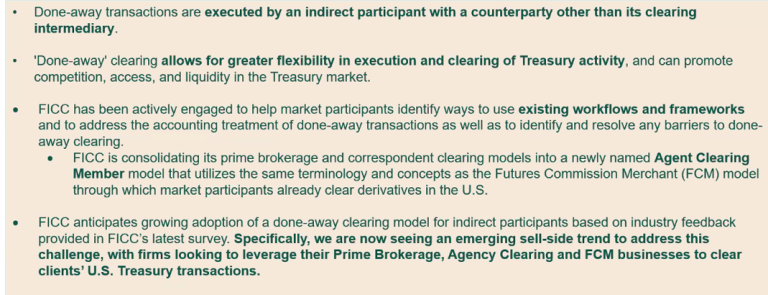Finadium’s Rates & Repo North America is now just around the corner on October 29 in New York, and we’re highlighting a few early insights as a sneak preview. In the last of a series of four articles, we hear from our experts Curvature Securities, DTCC and State Street, who will be speaking on the Clearing mandate, agency clearing and the done away model panel.
Over the last couple of years, repo market participants have gained a greater understanding of the types of clearing models that can be accessed and are now coming to terms with how the US Treasury (UST) and UST repo clearing rules will define the best option, said Jim Hraska, managing director for Clearing Agency Services at DTCC.
“Clients need to bring all financing in and a number of our members, especially those who are FCMs, swap clearers and prime brokers, have realized that they have many clients that need to bring activity in,” he said. “We created a set of flows and access models that we believe are applicable to all the participant segments; alternative asset managers, regulated asset managers the intermediaries and for the principal trading firm community.”
Hraska stressed that the simplest way to view the available options is to break them down into two models – sponsored and agented – with various choices for execution stemming from them, such as trading done away or done with as well as on a segregated or non-segregated basis.

Based on industry feedback, one of the essential features for done away is the ability to do a limit check, which will require credit checks and potentially a centralized hub that needs to happen “north of the CCP,” he added. Along with trade flow considerations, there’s a significant analysis of the accounting and legal rights and responsibilities under the agented model.
Sponsored vs. FCM-like
Currently, sponsored repo is the dominant buy-side access model but it’s unlikely that’s going to be sufficient to solely accommodate the shift into mandatory clearing. Thus, it’s difficult to see how the status quo is maintained, said Travis Keltner, managing director and head of Secured Financing at State Street.
Sponsored repo is currently the only live and successful solution, giving it a big head start to meet buy-side institutions’ emerging compliance needs, which are expected to play out up to the last minutes of the June 2026 deadline.
“While we grow and support our client’s needs through the sponsored program, State Street is heavily involved in exploring and advancing a path forward under new forms of done-with and done-away services,” Keltner said.
The “supply-demand mismatch of the future state” needs to consider both the anticipated increase in daily Treasury volumes through the Fixed Income Clearing Corporation (FICC), estimated at some $4 trillion, as well as the costs of clearing for firms depending on the model they choose, he added.
In other words, the done away model that will be serviced by DTCC and perhaps other clearinghouses could enhance an inefficient funding landscape by creating liquidity for this “insurmountable amount of demand”, but it is likely to have some additional costs as the clearing providers adjust to the market.
“We know the FCM model is a very thin margin business and it’s going to be important that the players that want to offer a done away service are very smart with how they construct it,” he said. “The providers who may support scale, the banks and broker dealers really have to look at their relationships, consider their capital returns and price it out – ultimately that is what is going to influence the new cost to clear. We think about this a lot.”
The ability to cross-margin with other treasury products in particular can be expected to grab the market’s attention by offering other forms of nettable activities with omnibus structures through broker dealers clearing futures, repo and cash.
“There’s likely going to be further benefits to offsetting exposures,” said Keltner. “You can see the winners offering, particularly for the hedge fund side, a combination of services that reduce their margin obligations.”
Prime vs. exchange-like
The Securities and Exchange Commission’s original goal was to centralize clearing and potentially encourage an “all-to-all” model, which is more exchange-like. Instead, the market is at risk of “fracture” said Scott Skyrm, executive vice president of Sales for Curvature Securities.
The way things are unfolding, repo market participants will end up with two or three central clearing counterparties, making it not central clearing but something like bi-central or even tri-central clearing, as major exchanges realize that there is a much broader business available, he explained.
What CME and ICE, for example, are now proposing is in the vein of an FCM model when weighing the launch of their treasury clearing businesses.
“New participants in the market might like an exchange model because it’s less business infrastructure,” he said. “But if you are a big bank and you’ve got a prime brokerage business and you’ve got large hedge funds that are clearing with you, you want them to execute with you also to capture that bid-offer business.”
Jim, Scott and Travis will be joining colleagues from Barclays, BNY and Finadium on the Clearing mandate, agency clearing and the done away model panel at Rates & Repo North America: the premiere conference for cash investors, dealers, market intermediaries, technology firms and other service providers. Register here for the October 29 in-person panel discussions.


